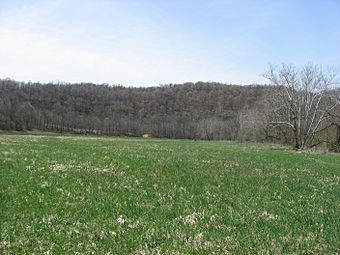Fisher site facts for kids
Quick facts for kids |
|
|
Fisher site (36GR21)
|
|

Overview of the site
|
|
| Location | Off Camp Resort Road along the Enlow Fork, in Richhill Township, Greene County, Pennsylvania |
|---|---|
| Area | 1.8 acres (0.73 ha) |
| NRHP reference No. | 82001536 |
| Added to NRHP | November 15, 1982 |
The Fisher site is a really important archaeological site in Greene County, Pennsylvania, United States. It's a place where an ancient village of the Monongahela people once stood. This site is located along a small river branch called the Enlow Fork. Experts say it's one of the most significant places in southwestern Pennsylvania for understanding prehistoric times.
Contents
Where is This Ancient Village?
The Fisher site is found in the floodplain of the Enlow Fork. A floodplain is a flat area of land next to a river that might get flooded when the river overflows. This spot is quite open, which is rare in the mostly wooded hills of northern Greene County. The forests around the site are part of State Game Lands 302. This is a public area where people can go hunting and fishing.
Who Lived Here?
Archaeologists have learned that the village at the Fisher site belonged to the Drew Phase of the Monongahela culture. The Monongahela people were a Native American group who lived in this region a long time ago. The Fisher site was the tenth Drew Phase village ever found.
What makes the Fisher site special is its location. Most Monongahela villages were built on hilltops. This was usually for protection, as different groups often fought each other. But the Fisher site is located down in a river valley, which is very unusual for a Monongahela village.
Digging Up the Past: What We Found
People who owned the land started finding old artifacts on the surface as early as the 1940s. But the Fisher site was first officially noticed by archaeologists in 1962. This happened during tests for natural gas wells in the area.
Fourteen years later, in 1976, the first archaeological dig took place. This investigation showed that the site was a village from the Late Woodland period. A third, more careful excavation happened just before 1981.
During this third dig, nearly 1,100 artifacts were found. These included animal bones, stone tools, and over 500 pieces of broken pottery, called potsherds. Some of these potsherds had very unusual geometric designs. No other site has ever produced pottery with these unique patterns.
Why is the Fisher Site Important?
Many ancient Monongahela sites in river valleys have been destroyed. This is because of lots of building and industry in southwestern Pennsylvania. Also, many unknown sites might have been lost due to surface mining for coal.
However, the area around the Fisher site is still very natural. There are only small roads, and no gas wells operate nearby, unlike in other parts of the township. Because the site is in such good condition, it's very likely to hold more information about the Drew Phase of the Monongahela culture. This phase is not well understood yet.
Because of its importance, the Fisher site was added to the National Register of Historic Places in 1982. This helps protect it for future generations to study and learn from.



